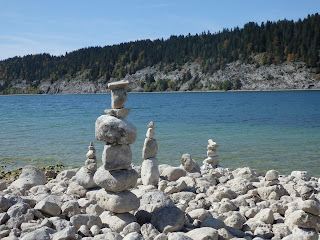"To Trains" the signs at Trondheim airport say and so I assume that by following them I will get to the airport train station. After quite some walking I ask a young couple that comes towards me from where I'm heading to where I can buy a train ticket. They don't know, they say, they have never taken a train. I continue to follow the signs that eventually point to stairs that lead downward to sliding doors, an empty platform and two equally empty railway lines on both sides of the platform. It is pitch dark, I'm the only human being in what feels like a science fiction scenario and so I decide to return to the arrival hall of the airport. As I climb up the stairs a young woman is heading down the stairs. Is this the station? I ask. I don't know, she says, I've never taken a train.
It was mine, says the elderly man standing next to me in the souvenir shop of the Nidaros Dom. I was slightly perplexed for I could neither place him nor what he just had said. But then it dawned on me that we had met in the elevator of the hotel where we both stayed and his "it was mine" referred to the room card that he had picked up from the elevator floor.
He was from Southern Norway. We talked about the unusually warm weather when all of a sudden he asked whether I knew Svalbard. Sort if, I said, for I had recently reviewed a photo book about it. It is really weird up there, he said. And dangerous. Because the polar bears eat you. You have to carry a gun at all times. It was warm when I was there, ten above zero, the ice was melting. The polar bears couldn't find anything to eat for they cannot hunt for fish from moving ice blocks. They soon will be extinguished.
With a Norwegian she could never have such a conversation, says the Romanian waitress, who has lived here for quite some years and with whom I had by then chatted for a few minutes. My own Norwegian experience is different (see the above paragraph), the fact that I often take the initiative and start talking is surely a contributing factor. Especially animating conversations I've had with the receptionists at my hotel (one was a martial arts instructor, another knew how to read Braille – one day, in his student dormitory, he had come across an instruction manual and decided to teach himself reading like the blind), the manager of two 7/11s (he had dropped out of informatics studies because he did not feel like spending most of his working hours in front of computer screens and loves the variety of tasks he is now daily dealing with) and the manager of a poster store that sells photographs in various large formats (the ones that sell best are prints in black and white that show scenes from the Tour-de-France – for reasons unbeknownst to her).

To get away from your usual environment means to experience slower and longer days for you have much more time on your hands. It also means to make discoveries. In Trondheim, for instance, there's the Rockheim, the national museum of popular music where highly knowledgeable and friendly staff will introduce you to Norwegian Rock and Pop. Moreover, the town is full of fabulous architecture and breathtaking scenery.
I also learned that waffles are a Norwegian tradition, in my hotel they were offered for free in the evenings. Another of my culinary discoveries were shrimp baguettes. The first one I had was open so that I could see that there were two slices of lemon on top of the shrimps, the second one however came wrapped in plastic and it didn't occur to me that there could be lemon slices included until I had swallowed one.





























